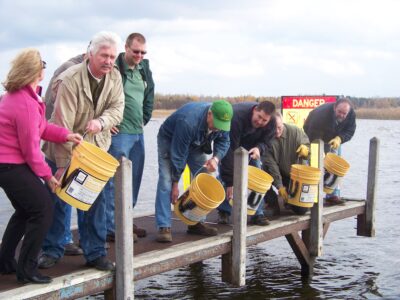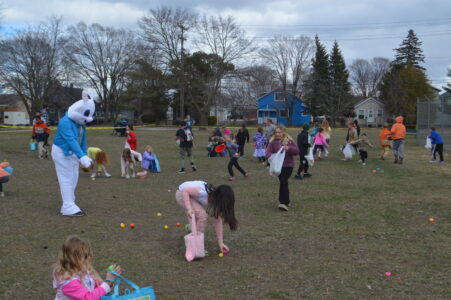Walleye in Bays healthy as season opener nears

Photo courtesy of Vickie Micheau Volunteers prepare to release walleye fingerlings into Little Bay de Noc from the Rapid River Boat Launch in 2010.
By R. R. Branstrom
rbranstrom@dailypress.net
ESCANABA — What is the state of the Bays de Noc with the opening of walleye season less than a month away? What will opening day on May 15 have for local anglers. According to Michigan DNR officials, the population of walleye and other sport fish are reproducing and healthy.
“Northern Green Bay continues to host self-sustaining populations of many prized species of sport fish,” wrote local DNR Fisheries Biologists Troy Zorn and Darren Kramer in a report published this month.
Data suggests that walleye in the Bays de Noc are “reproducing and generally healthy,” said Zorn, though the environment has changed. The species present in the Great Lakes and their populations are far different from 30 years ago, and ongoing studies continue to monitor abundance of fish and their food sources.
Creel surveys, which gather information from anglers about what they’re catching and how they’re targeting; and studies done annually by the DNR, using experimental mesh gill nets, trawls, and jaw tags, all provide information on how fish trends fluctuate with changes in the lake.
For example, more northern pike were found when the water levels were high, beginning in 2014; Zorn and Kramer hypothesized that “water levels enhanced northern pike reproduction by inundating shoreline wetlands, making considerably more emergent wetland habitat available throughout each bay for egg deposition and fry growth and survival.” The number of pike caught by gill nets during DNR surveys in both Little and Big Bay de Noc remained higher from 2014 to 2024 than they had been in 2013.
When dreissenid mussels (first zebra and then quagga, both of the genus “Dreissena”) invaded the Great Lakes in the 1990s and 2000s, one problematic side effect was that they fed on the same zooplankton consumed by walleye fry and others. Competition for food didn’t get so drastic that the population was endangered, but increased clarity of the water means that fewer forage fish are found in the middle of the water column and there are “more seasonal movements of walleyes out of Little Bay de Noc,” said Zorn.
One recommendation by the DNR a few years ago when plankton levels were low was for those stocking fish to wait until the fish had grown past the planktivorous stage before release. Some recent stocking efforts have been placing larger fish into the bay.
Recognizing that slightly fuller-grown fingerlings have better survival rates, a walleye restoration project that releases young walleye up to eight inches long into Little Bay de Noc is committed to helping the area remain “a premier destination for fishing enthusiasts year-round” and has been ongoing for almost 15 years, said Delta County Chamber of Commerce Executive Director Vickie Micheau. That stocking is done by the Hannahville Indian Community, Great Lakes Sport Fishermen, the DNR, Visit Escanaba, the Chamber of Commerce, and volunteers.
“Analyses we have done suggest that stocking provided a noticeable contribution to the walleye fishery in Little Bay but not Big Bay de Noc … with natural reproduction being the most important contributor to the adult walleye population in Little Bay de Noc,” Zorn said.
Little Bay de Noc’s tributaries continue to provide better spawning areas than those that lead to its larger neighbor to the east.
Rivers and streams often offer more warmth, nutrients and protection than open water, and those that feed into Little Bay “offer rapids with coarse substrates for spawning walleyes, while major tributaries to Big Bay de Noc are typically smaller and predominantly sandy in their lower reaches, providing limited spawning habitat for walleyes,” reads a 2020 article from the Journal of Great Lakes Research.
Gill net survey catch rates indicate that the number of walleye in the smaller bay have been climbing gradually upward since 2014. Yellow perch populations seem to be relatively stable. Smallmouth bass may be increasing slightly.
The types of fish caught during trawl studies in Little Bay de Noc, in which nets are dragged along the bottom for ten-minute periods in August, shifted towards being round goby-heavy in 2001. Prior to that point, trout-perch and yellow perch were primarily the catch of trawls. 2021 saw the most number of invasive round gobies netted, with about 200 caught in a ten-minute trawl.
Another invasive fish whose population has climbed recently is the Eurasian ruffe. They were present in low numbers in Little Bay de Noc since the early 2000s, but the count shot up beginning in 2017.
“Eurasian ruffe were the third most abundant fish in our 2022 Little Bay de Noc fish community assessment survey,” wrote Zorn and Kramer.
Species that increased from the 1990s to the 2010s were the longnose gar, freshwater drum and black bullhead, according to a 2021 publication by Zorn and Kramer. Those that decreased were trout-perch, common carp, chinook salmon, splake, and rainbow smelt.
The lake sturgeon population has been increasing in Little Bay de Noc since reintroduction stocking efforts began in 2006.
The DNR conducts surveys in the Bays de Noc annually. In August, their trawl studies are done all in one day, and in September, they set about three gill nets per day over a two week period, Zorn said. Data is also collected from points outside the bays to the east, in Manistique and Naubinway, and to the west, in Cedar River and Menominee, in alternate years. These standardized assessments began in 2009.
Periodically, the DNR also conducts acoustic telemetry-based studies of walleye movements. This week, they were at the Rapid River Boat Launch to put jaw tags on walleyes. This spring’s movement study is a partnership with the Wisconsin DNR and University of Wisconsin- Stevens Point.
“Walleye will continue to be a major player in the Little Bay de Noc fishery for some time to come, but the bay and its fish community have been changing and will continue to do so over time,” Zorn said.



